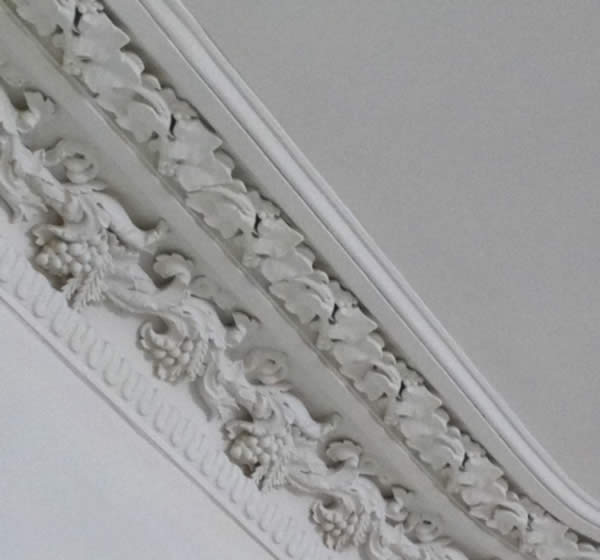Quick Summary:
Water leaks or damp patches often leave plaster coving stained, soft, or even crumbling. Fixing water-damaged coving requires careful assessment, drying, repair, and, in some cases, replacement using traditional methods. This guide explains the exact steps to restore coving safely and effectively.
Why Does Coving Get Water Damage?
Coving is made from plaster (lime or gypsum), which is porous and easily absorbs moisture. Common causes include:
-
Roof leaks or faulty flashing
-
Burst or leaking pipes
-
Condensation and damp problems
-
Previous water ingress left untreated
If left unresolved, water-damaged coving can:
-
Crack, sag, or crumble
-
Lose decorative detail
-
Cause staining and mould growth
Step-by-Step Guide: Fixing Water-Damaged Coving
1. Identify & Stop the Source of Moisture
Before repair, fix the root cause — whether it’s a leaking pipe, roof damage, or condensation issue. Otherwise, the damage will return.
2. Dry Out the Coving Thoroughly
-
Use fans or dehumidifiers to remove trapped moisture.
-
Allow at least several days of drying before repair.
-
Avoid rushing, as damp plaster won’t hold filler or paint properly.
3. Assess the Extent of the Damage
-
Minor staining & surface cracks → cleaning + filler may be enough.
-
Soft or crumbling plaster → sections may need cutting out and replacing.
-
Severe damage → replication of the coving pattern is often required.
4. Remove Loose Material
-
Scrape away soft, flaking plaster.
-
Sand gently to expose solid coving.
-
Take care not to damage surrounding details.
5. Repair or Replace
-
Small cracks & holes → fill with specialist plaster filler.
-
Damaged sections → a mould is taken from the original pattern, and a new piece is cast in lime/gypsum plaster.
-
Installation → the new section is fixed in place and blended seamlessly with the old.
6. Finish & Paint
-
Once dry, sand lightly for a smooth finish.
-
Apply a stain-blocking primer before repainting.
-
Spray painting ensures a crisp finish without clogging details.
Can You DIY Water-Damaged Coving Repairs?
Small cracks and stains can be tackled by confident DIYers.
However, for:
-
Listed buildings
-
Decorative or ornate coving
-
Severe water damage
…it’s best to call a specialist plaster restorer to preserve the original features and achieve an invisible repair.
Frequently Asked Question
Q: How much does it cost to repair water-damaged coving?
A: The cost varies significantly with the damage. Minor DIY repairs may cost under £100 for materials. Professional repairs for localized damage typically range from £200 – £500, while full section replacement for ornate coving can run into the thousands. We provide free, photo-based estimates for accurate pricing.
Q: Will the brown stains come back after repainting?
A: No, not if you use the right products. The secret is applying a dedicated stain-blocking primer before you paint. This creates a barrier that seals the tannins and water marks in, preventing them from bleeding through your new paint job.
Q: Is it safe to restore coving in a listed building?
A: Yes, absolutely. In fact, it’s often required to maintain the building’s character. The key is using the correct, breathable traditional materials (like lime plaster) and methods that comply with Historic England guidelines, which all reputable specialists should follow.
Q: Can you repair coving without replacing the whole section?
A: In many cases, yes. Skilled restorers can often “surgically” remove only the damaged portion and patch in a new piece, saving the majority of the original coving. This is more complex but preserves the historical fabric of your home.
About Cornice Cleaning Ltd
With over 40 years of experience, Cornice Cleaning Ltd is London’s trusted name for the sympathetic restoration of period plasterwork. We are craftsmen, not just builders. We specialize in using traditional steam cleaning and lime/gypsum plaster techniques to repair and preserve the historic character of properties, from Victorian terraces to Grade II* listed landmarks like the Charles Dickens Museum. Our work doesn’t just fix problems—it honors history.
Customer Success Story
The Leaky Roof in a Victorian Islington Home:
A prolonged roof leak went unnoticed in an attic, causing a large section of ornate Victorian coving to become soft and crumble. The homeowner was worried the entire room’s coving would need to be replaced.Our Solution: We first helped identify the roofer to fix the leak. Once dry, we carefully cut out the damaged section, created a silicone mould from an intact part of the coving, and cast a perfect replacement in gypsum plaster.
The Result: “The repair is completely invisible. You cannot tell where the old ends and the new begins. They saved us the immense cost and disruption of replacing all the coving and preserved a beautiful original feature we thought was lost.”
📍 Based in London — covering North London, East London, and beyond
📞 Call us today for a free quote: 07956 332144

